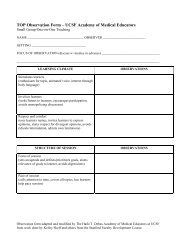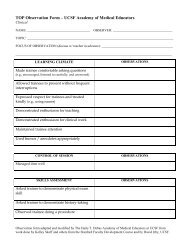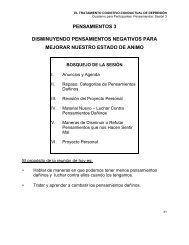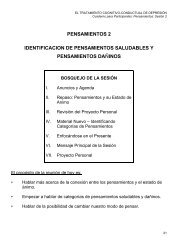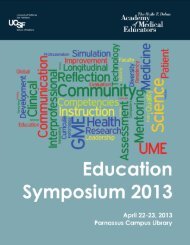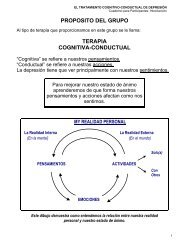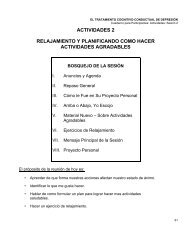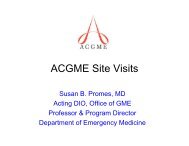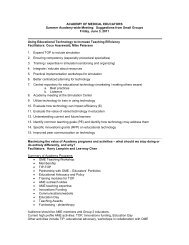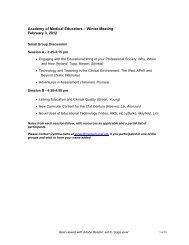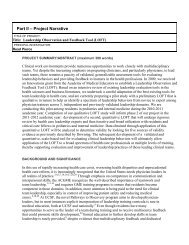2011 - UCSF School of Medicine - University of California, San ...
2011 - UCSF School of Medicine - University of California, San ...
2011 - UCSF School of Medicine - University of California, San ...
You also want an ePaper? Increase the reach of your titles
YUMPU automatically turns print PDFs into web optimized ePapers that Google loves.
<strong>UCSF</strong> Education Day <strong>2011</strong>Screening, Brief Intervention, andReferral to Treatment (SBIRT) forSubstance Use Disorders amongResident Physicians: CurriculumDevelopment and PreliminaryEvaluationNeda Ratanawongsa, MD, MPH, <strong>UCSF</strong>, <strong>San</strong> Francisco,<strong>California</strong>, RatanawongsaN@medsfgh.ucsf.edu; JenniferManuel, PhD, <strong>UCSF</strong>, <strong>San</strong> Francisco, <strong>California</strong>,jennifer.manuel@ucsf.edu; Daniel Ciccarone, MD, MPH,<strong>UCSF</strong>, <strong>San</strong> Francisco, <strong>California</strong>,ciccaron@fcm.ucsf.edu; Jennifer Hettema, PhD,<strong>University</strong> <strong>of</strong> Virginia, Charlottesville, Virginia,JEH7DV@hscmail.mcc.virginia.edu; Brad Shapiro, MD,<strong>UCSF</strong>, <strong>San</strong> Francisco, <strong>California</strong>,Brad.Shapiro@ucsf.edu; Sharad Jain, MD, <strong>UCSF</strong>, <strong>San</strong>Francisco, <strong>California</strong>, sharad.jain@ucsf.eduAreas abstract covers: UME, GME, CMEDomain(s) addressed: Clinical Instruction andPerformance, Evaluation <strong>of</strong> Programs and CurriculaPurpose: A residency curriculum was developed toenhance residents’ confidence and skills with usingSBIRT (Screening, Brief Intervention and Referral toTreatment)Background: SBIRT conducted in medical settings iseffective in reducing risky alcohol and drug use. Selfreporteddiscomfort and lack <strong>of</strong> experience dealing withalcohol and drug problems are associated with lowerconfidence in SBIRT skills among <strong>UCSF</strong> internalmedicine resident physicians. Moreover, half <strong>of</strong> clinicpatients surveyed anonymously at the teaching countyhospital reported lack <strong>of</strong> counseling about safe drinkinglimits by their providers.Methods: We implemented a 7-week, 32-hourlongitudinal SBIRT curriculum for internal medicineresidents (n=32) at the teaching county hospital. Thecurriculum included SBIRT didactics, small groupdiscussions, skills practice role-plays, and site visits tolocal substance use treatment and referral programs.Written narrative reflections, clinical case discussions,and clinical observation checklists were used to evaluateresidents.Evaluation Plan: Qualitative analysis <strong>of</strong> residents’narrative reflections showed an increase in confidenceusing SBIRT skills with their patients. Residents citedlack <strong>of</strong> time, competing work responsibilities, lack <strong>of</strong>preceptor support, and patient resistance as barriers tocontinued use <strong>of</strong> SBIRT. Analysis <strong>of</strong> qualitative checklistdata revealed that residents screened skillfully forsubstance use disorders and employed patient-centeredlistening skills, while struggling with “rolling withresistance” and formulation <strong>of</strong> specific action plans.Dissemination: Dissemination plans include presentingSBIRT curriculum development through posterpresentations and publications in scientific journals. Weare currently working on website development andpossibly a video <strong>of</strong> the SBIRT approach.Reflective critique: Feedback from the residents andtraining staff has been solicited ongoing in order tomodify the training and feedback portions <strong>of</strong> thecurriculum.Student Created Modules to GuidePortfolio ImplementationNicklaus Brandeh<strong>of</strong>f, <strong>University</strong> <strong>of</strong> <strong>California</strong>, <strong>San</strong>Francisco, nicklaus.brandeh<strong>of</strong>f@ucsf.eduAreas abstract covers: UMEDomain(s) addressed: Competencies, CurricularInnovation, Longitudinal Educational Activities, PortfoliosPurpose: To describe a student-created step-by-stepguide to help student set up and become familiar withthe MD Portfolio at <strong>UCSF</strong>.Background: In 2009 <strong>UCSF</strong> SOM launched MDPortfolio for students to provide evidence <strong>of</strong> achievement<strong>of</strong> competencies expected by graduates. The systemincluded opportunities for uploading evidence, criticalreflection and obtaining feedback. However, introduction<strong>of</strong> the portfolio required orientation to its purpose andguidance on how to use the electronic platform. Themodules created provided this introduction andguidance.Methods: Faculty advisors in education and technologywere consulted to determine their vision <strong>of</strong> the MDPortfolio and to identify key items to help studentsbecome familiar with the portfolio concept. Six pilotonline competency examples using the Mahara platformand one online introduction module using ArticulateEngage s<strong>of</strong>tware were created and posted to the E-Portfolio September 2009.Evaluation Plan: During development a group <strong>of</strong> 5students and 2 faculty tested the modules for clarity,design and ease <strong>of</strong> use. Before final release, a group <strong>of</strong>18 students evaluated modules for accessibility, design,ease <strong>of</strong> use, and overall incorporation into the E-Portfoliosystem.Dissemination: Presentations were done at theCurriculum Ambassador Showcase 2009, Class <strong>of</strong> 201322 The Haile T. Debas Academy <strong>of</strong> Medical Educators



